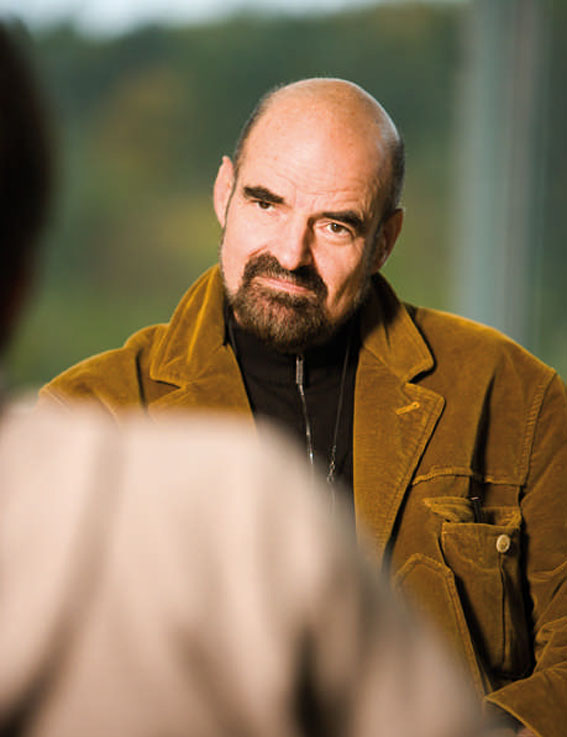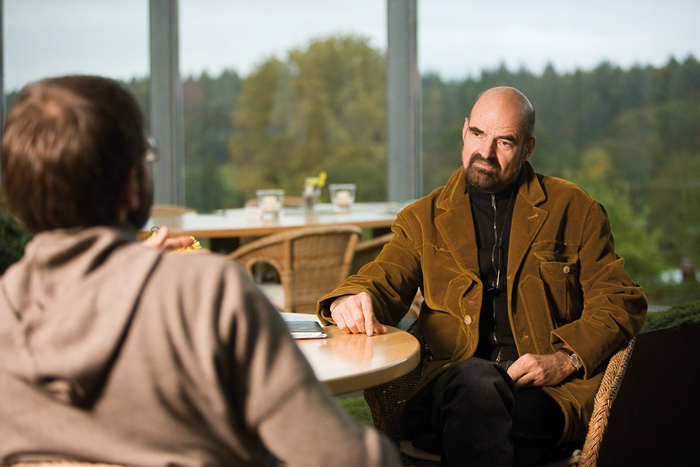"Everything important is taught in the very first lesson!" – Interview instead of editorial – part 2
 As promised, here is the continuation of the interview – giving up-to-date answers to further important questions.
As promised, here is the continuation of the interview – giving up-to-date answers to further important questions.
 |
| Markus Senft interviewed GM Kernspecht for WTW online |
During our last conversation you said that for over 50 years, you have always been looking for a self-defence system that solves all possible problems with as few movements as possible.
So you have not forgotten the beginning and end of our dialogue. About my "unspecific" movements. After studying with Prof. Tiwald I would now prefer to call it unspecific "moving", as we are talking about specific techniques against something in particular, but about a general way of moving.
In the belief that I had seen something similar from the Korean Masutatsu Oyama, it seemed to me that one could defend against and possibly counter all manner of punches with arm movements "resembling the blades of a fan".
The more I became immersed in Karate, the more I abandoned this idea, as I was allowing myself to be overloaded with movements (techniques). The means were overrunning the purpose.
You no longer saw the wood for the trees?
I had forgotten why I started learning this. I was now learning Karate. But what I wanted to learn was how to defend myself.
They did not teach you to defend yourself …,
… instead they taught me their Karate style.
They did not teach you …,
... but rather Karate! I am pleased to see that my use of language has fallen on fertile ground.
How do you see Karate now? You even hold the 3rd Dan, do you not?
For ten years I first taught Kempo, then Karate in the "Budo-Zirkel Kiel". I now remember that the Kempo style I learned from a Belgian or Dutchman had precisely such "fan blade-like movements" in which the opponent’s attack was bound to become entangled. And I now also know that Master Oyama had learned Kempo, i.e. original KungFu.
I am certain that you have also found the original Chinese style.
You know me well. I also studied it in detail. Later it led me to Wing Chun, which I learned in London’s Chinatown from Sifu Joseph Cheng, a student of GM Lee Sing, in the early 1970s. In 1975 Joseph "referred" me to Leung Ting, from whom I learned WingTsun to the 10th grandmaster level and beyond.
Did you find your unspecific movements in WingTsun?
Yes, but here too, I was distracted from the actual purpose by the overwhelming and detailed techniques in the partner forms. It is like being in a restaurant, when the waiter asks me how I found the steak. My answer: "Hidden beneath the sauce that was drowning it, and the accompaniments that were there to fill me up!"
And where is the unspecific hidden in our WT?
In my "Essence" I assert that "Everything important is already taught in the first lesson."
For the beginner this applies to the unmoving stance during the SNT form. And for the advanced student it applies to the very first ChiSao exercise, the "rolling arms" (PoonSao).
As in a nucleus, this "rolling of the arms" already contains everything in combination with the three levels and the idea of "sticking" and deceptively adapting oneself, of taking the lead and then suddenly descending on the prey like a raptor at the right moment.
In your book "On Single Combat" you quote the classic adage: "I fear the reader of only one book!"
Yes, in a sense this underestimated PoonSao, which is probably also practiced with the wrong attitude, is this one book which contains everything needed.
Really everything?
No, of course not. It is still missing the right energy. Striking power. Footwork. The Big Seven.
Your Big Seven are Attentiveness, Adroitness, Balance, Physical unity, Interaction of the senses, Timing and sense of distance, Fighting spirit.
These are the indispensable capabilities that a fighter must possess to defend himself?
To defend himself using "our WT"! If he wants to defend himself with e.g. Kickboxing, he needs quite different capabilities such as strength, speed of movement, endurance, the ability to take punishment etc.
And how or where does the student develop these seven capabilities?
In the classical view, by practicing the solo forms. My Chinese master has added to these with his partner forms, i.e. application forms.
And you? What do you think of this?
I am experimenting with exercises that develop these capabilities specifically, simply and without detours. Without the forms or the need to memorise, i.e. taking a direct route.
Many are concerned that you intend to abolish the classic WT forms.
That would be nonsense! After all, we only have four short boxing forms. I neither want to abolish them nor change them.
So what is your criticism of the forms?
They must not be the main teaching method. Partner training under guidance that directly addresses the Big Seven is at least as important.
And otherwise?
Leaving the 3rd form and perhaps the Wooden Dummy form aside, I think there is not enough flow when practicing the forms. Constantly stopping and pausing in the final positions is counter-productive with respect to the aims of WT as a fighting system.
What is to blame for this?
An incorrect understanding of the motto "Dim dim ching" (Every point clear). The student is constantly unsure whether he is performing the technique correctly, checks his final position in the mirror or waits for the ok of his teacher before continuing. The student therefore develops a habit of pausing in final positions, and fails to develop the "flow".
But isn’t this more of a teaching problem?
Yes, the teacher needs to be enlightened in this respect. There is nothing fundamentally wrong in WingTsun. But it must remain possible to examine the teaching method critically from a scientific point of view. We must not shy away from this out of sheer piety.
But to do this we need to be aware of the goals we want to achieve with WT, the principles etc.
One goal is the develop the capability of defending oneself.
Another is to develop attentiveness.
Another is to maintain or restore good health.
But the desire for personal safety was probably first and foremost.
That is why our conversation next time will be about how we in the EWTO rapidly meet this first, basic need with the help of WT, naamely with BlitzDefence.
The interview with Markus Senft will be continued in November …


